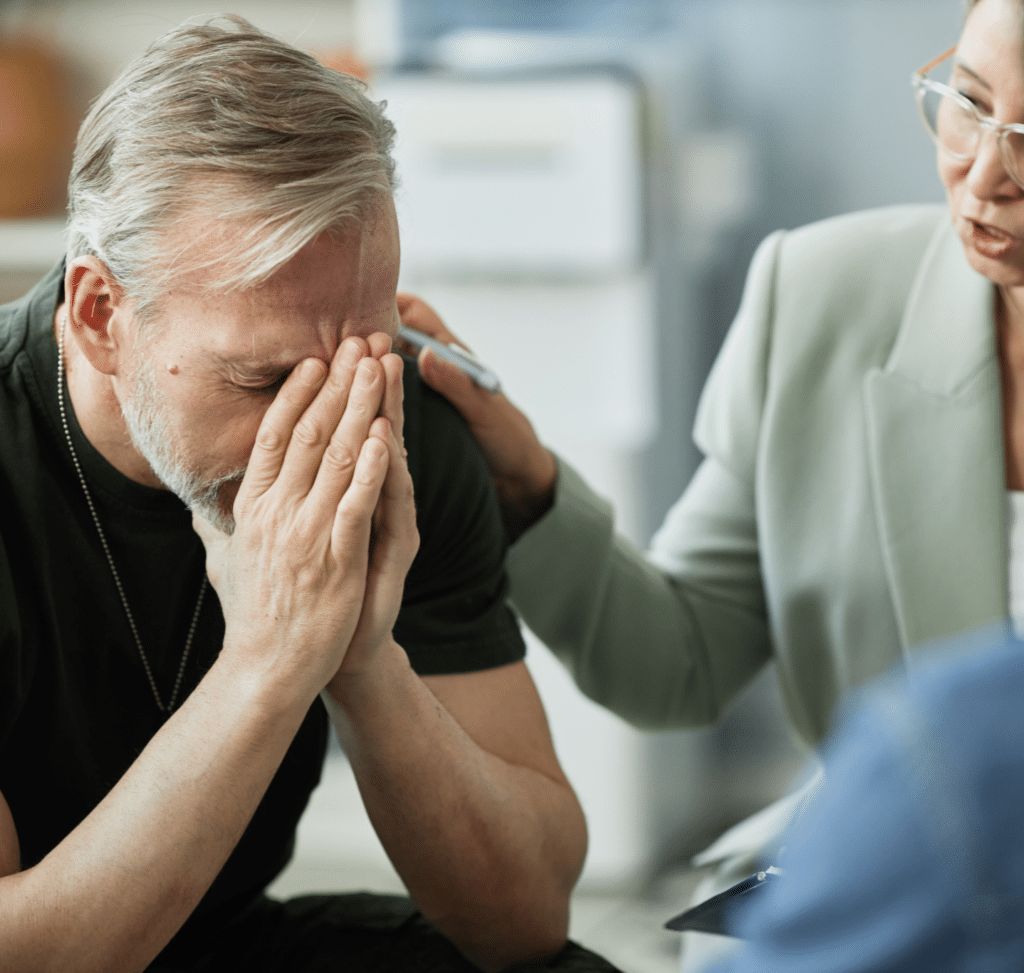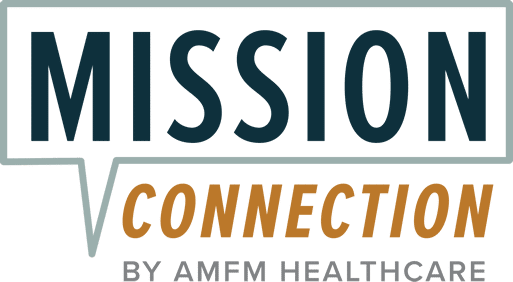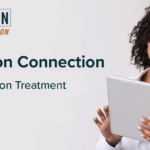Depression and PTSD – How They Are Connected

Dealing with mental health challenges can be overwhelming, especially when two disorders seem to be occurring together at the same time.
Estimates can vary, but approximately 30% to 50% of people with post-traumatic stress disorder (PTSD, for short), can experience significant symptoms of depression.¹ While both are different types of mental health conditions, some of the symptoms can overlap, making it more challenging than having just one condition alone.²
Both conditions can have a severe impact on your moods, the way you think, and your ability to function effectively in daily life. Having both together can only worsen this impact. However, while it may feel impossible to manage your symptoms at times, there is good news. These conditions are treatable and some people have gone on to make a full recovery.
If you’re looking to understand more about PTSD or how severe depression could be linked to past trauma, you’ll find this resource a helpful primer. We will be covering:
- What depression and PTSD are and how they differ from each other
- The symptoms of depression and PTSD
- How depression and PTSD may be related
- Treatment options
- When to seek help for depression and PTSD

Key Takeaways
- Trauma and stress disorders such as PTSD frequently co‑occur with depression — having one significantly increases risk for the other.
- Individuals with both PTSD and depression often experience more severe symptoms, greater emotional burden, and increased treatment complexity than those with depression alone.
- Understanding overlapping symptoms — such as mood changes, flashbacks, anxiety, sleep disruption, negative thoughts — is key for accurate diagnosis and effective treatment.
- Comprehensive care that addresses both trauma‑related stress and depressive symptoms is often most effective, offering better long‑term support and recovery potential.
Table of Contents
What Is Depression?
Depression is a type of mental health disorder that affects your moods. It can cause you to persistently feel sad, empty, irritable, or lose interest in things you once loved. When something’s persistent, it means the condition can last a long time or keep coming back.³
Everyone feels sad and low at various times, but for most people, these feelings usually pass without causing too much difficulty. You may be having depression that requires professional intervention if these feelings continue and start to seriously impact how you think, feel, sleep, eat, or perform your daily tasks.⁴
There are different types of depression, also called depressive disorders, and these are classified into the following subtypes:⁵
- Major Depressive Disorder (MDD)
- Persistent Depressive Disorder (PDD, or known as “Dysthymia”)
- Bipolar Depression
- Seasonal Affective Disorder (SAD)
- Psychotic Depression
- Postpartum Depression (PPD)
- Premenstrual Dysphoric Disorder (PMDD)
- Atypical Depression
- Situational Depression
- Substance-Induced Depressive Disorder
- Depression Due to a Medical Condition
- Masked Depression (no longer a diagnostic term)
- Double Depression (not a diagnostic term, but refers to having MDD and PDD at the same time)
- Treatment-Resistant Depression
- Endogenous Depression
- Exogenous Depression
The type of disorder can depend on the duration, timing, and cause. Each disorder also has its own list of symptoms used to identify it.
What Is PTSD?
Post-traumatic stress disorder (PTSD) is a common and complex mental health condition that can arise after exposure to a traumatic event.⁶ In adults, they may have been exposed to actual or threatened death, serious injury, or sexual violence. The exposure itself can take one or more of the following forms:
- Directly experiencing the traumatic event
- Seeing the event take place to someone else or other people
- Learning that the event took place to a close friend or family member
- Experiencing repeat or extreme exposure to elements of the traumatic event that you may have an aversion or strong dislike for (such as hearing the details of child abuse from police officers)
However, not everyone who experiences trauma will go on to develop PTSD.⁶ PTSD takes place when the trauma causes symptoms that significantly impair your ability to function at home, socially, or at work.
Research suggests that women are more likely to develop PTSD than men, and veterans, especially those deployed to a war zone, are also more likely to develop PTSD compared to civilians.⁷
Difference Between Depression and PTSD
Depression is a mood disorder that can have different causes. It may be hard to point out any specific reason. It may not even be the result of a specific issue or event, although that can also be the case. PTSD, on the other hand, is a disorder that can have severe symptoms as a result of a traumatic event.
It isn’t necessary that a person who has depression will go on to have PTSD. However, people with PTSD are more at risk of struggling with depression.
How Are Depression and PTSD Connected?
Although further research is needed to clearly establish the links between depression and PTSD, research suggests that:
- Exposure to psychological trauma either directly or indirectly may result in a form of depression identified as trauma-related depression.8
- 30% to 50% of people with PTSD experience symptoms of depression.
PTSD could be a sub-type of Major Depressive Disorder, and depending on trauma exposure, genetic and environmental factors, an individual could have PTSD, MDD, or a combination of both.9
PTSD and Depression Symptoms
Symptoms of PTSD
PTSD is a complex condition, and the symptoms can vary from individual to individual. It’s possible to see:6
- Intrusive Thoughts: Where you have recurrent and intrusive thoughts or dreams related to the traumatic event, flashbacks, and intense psychological or physical distress when reminded about it.
- Avoidant Behaviors: Where you avoid or try to avoid memories, thoughts, and any external reminders like people, places, activities, conversations, or situations related to the event.
- Negative Changes in Mood and Thoughts: Some examples of these are not being able to remember important aspects of the traumatic event, persistent negative emotions like fear, anger, guilt, or shame, and loss of interest in important activities that used to be enjoyable.
- Changes in Responses or Reactions: These include behaviors like irritability or aggressive outbursts with little or no provocation, reckless or self-destructive behavior, and sleep disturbances.
Any of the symptoms, if experienced, should have lasted for more than a month to be classed as PTSD.
Symptoms of Depression
Although there are different types of depressive disorders, causing symptoms to vary, the common symptoms are persistent sadness, emptiness, or irritable mood. Other symptoms you may see in those with depression are:10
- Loss of interest or pleasure in all or almost all activities
- Significant weight loss or weight gain
- Sleep problems
- Fatigue
- Feelings of worthlessness or excessive/inappropriate guilt
- Lowered ability to think or concentrate
- Inability to make a decision
Depression and PTSD Treatment Options
There is no one-size-fits-all solution for depression and PTSD, especially when they co-occur. However, treatment options in the form of therapy and/or medications can be helpful to improve symptoms, and in many cases, they may help to make a full recovery.
Therapy for Depression and PTSD
Therapeutic approaches are often tailor-made for individuals to ensure they have the best and most long-lasting outcomes.
For example, at Mission Connection, we start with a comprehensive assessment followed by evidence-based therapy approaches. We ensure that you’re fully supported throughout your journey with us and have access to caring and highly-trained mental health professionals.
That’s not all. We ensure you have access to education and training so you can learn how to cope and overcome difficult situations and improve your resilience in the process.
Here are some of the approaches we use, and may include within your treatment plan:
Cognitive Behavioral Therapy (CBT)
CBT is focused on identifying and processing negative thought patterns that may be contributing to your symptoms.
Dialectical Behavior Therapy (DBT)
DBT has been found especially helpful for people who have intense emotions and have a hard time managing and regulating them.
Interpersonal Therapy (IPT)
IPT helps you identify the triggers in social situations and help improve your ability to function well in social settings.
Supportive Therapy (ST)
ST is used to help make people feel validated, supported, and encouraged. It helps improve coping skills, resilience, and confidence.
Eye Movement, Desensitization, and Restructuring (EMDR)
EMDR is specifically used to treat PTSD and involves the processing of traumatic memories together with specific eye movements.11
Cognitive Processing Therapy (CPT)
A specific type of CBT that has been found most beneficial in reducing the symptoms of PTSD.
Prolonged Exposure Therapy (PE)
Another form of CBT that teaches people to gradually approach trauma-related feelings, memories, and situations without fearing or avoiding them. Once the fears are confronted, it can be helpful to reduce the symptoms of PTSD.
Depression and PTSD Medication
Depression medications (also known as “antidepressants”) come in many different forms. Each works in slightly different ways. Let’s break it down:12
Selective Serotonin Reuptake Inhibitors (SSRIs)
SSRIs are usually the first-line treatment for depression for most people because they’re effective and generally better tolerated than other antidepressants. Examples: Fluoxetine (Prozac) and Sertraline (Zoloft).
Serotonin and Norepinephrine Reuptake Inhibitors (SNRIs)
They help to increase the levels of both serotonin and norepinephrine in the brain. Examples: Duloxetine (Cymbalta) and Venlafaxine (Effexor XR).
Atypical Antidepressants
They change the levels of one or more of the neurotransmitters serotonin, norepinephrine, and dopamine. Examples: Bupropion (Wellbutrin) and Trazodone (Desyrel).
Tricyclic and Tetracyclic Antidepressants
They’re effective, but can cause more severe side effects. They’re usually prescribed for severe or treatment-resistant depression. Examples: Amitriptyline (Elavil) and Maprotiline (Ludiomil).
Monoamine Oxidase Inhibitors (MAOIs)
They block an enzyme called monoamine oxidase from breaking down serotonin, norepinephrine, and dopamine in the brain. Examples: Selegiline (Emsam skin patch) and Isocarboxazid (Marplan).
N-methyl D-aspartate (NMDA) Antagonist
Found beneficial for treatment-resistant depression in some patients. The medication in use is Esketamine nasal spray.
Neuroactive Steroid Gamma-Aminobutyric Acid (GABA)-A Receptor Positive Modulator
Used for the treatment of moderate to severe Postpartum depression or PPD in women. The medication currently in use is Brexanolone (Zulresso).
Your healthcare provider will look at a number of different factors, such as your symptoms, lifestyle, existing medical conditions, antidepressant benefits and side effects, and your personal preference, before deciding the best one for you.
In terms of PTSD, the following medications have been found to be the most effective:7
- Sertraline (Zoloft)
- Paroxetine (Paxil)
- Venlafaxine (Effexor)
Seek Treatment for Depression and PTSD Today
Living with depression and PTSD, or either one for that matter, can be a challenging and distressing experience. When they both occur together, it can create unique challenges for healthcare providers. But there is hope.
At Mission Connection, we recognize the amount of courage it takes to seek help. Our team of mental healthcare experts specializes in treating instances of depression and PTSD occurring together through evidence-based approaches.
Our aim is to create a safe space for you where we can help you address your trauma and symptoms with empathy and compassion. You don’t have to face these challenges alone. Connect with a member of our team today and find out how our trained professionals can help you reclaim your health and well-being.

References
- Campbell, D. G., Felker, B. L., Liu, C. F., Yano, E. M., Kirchner, J. E., Chan, D., Rubenstein, L. V., & Chaney, E. F. (2007). Prevalence of Depression–PTSD Comorbidity: Implications for clinical practice guidelines and primary care-based interventions. Journal of General Internal Medicine, 22(6), 711–718. https://doi.org/10.1007/s11606-006-0101-4
- Flory, J. D., & Yehuda, R. (2015). Comorbidity between post-traumatic stress disorder and major depressive disorder: alternative explanations and treatment considerations. Dialogues in Clinical Neuroscience, 17(2), 141–150. https://doi.org/10.31887/dcns.2015.17.2/jflory
- Chand, S. P., & Arif, H. (2023). Depression. In StatPearls. StatPearls Publishing. https://www.ncbi.nlm.nih.gov/books/NBK430847/
- Depression. (n.d.). National Institute of Mental Health (NIMH). https://www.nimh.nih.gov/health/publications/depression
- The Diagnostic and Statistical Manual of Mental Disorders, Fifth Edition, Text Revision (DSM-5-TR)
- Mann, S. K., Marwaha, R., & Torrico, T. J. (2024). Posttraumatic Stress Disorder. In StatPearls. StatPearls Publishing. https://www.ncbi.nlm.nih.gov/books/NBK559129/
- U.S. Department of Veterans Affairs. (n.d.). PTSD: National Center for PTSD. https://www.ptsd.va.gov/understand/common/common_adults.asp
- Wang, S., Feng, M., Fang, Y., Lv, L., Sun, G., Yang, S., Guo, P., Cheng, S., Qian, M., & Chen, H. (2023). Psychological trauma, posttraumatic stress disorder and trauma-related depression: A mini-review. World Journal of Psychiatry, 13(6), 331–339. https://doi.org/10.5498/wjp.v13.i6.331
- Zhang, F., Rao, S., Cao, H., Zhang, X., Wang, Q., Xu, Y., Sun, J., Wang, C., Chen, J., Xu, X., Zhang, N., Tian, L., Yuan, J., Wang, G., Cai, L., Xu, M., & Baranova, A. (2021). Genetic evidence suggests posttraumatic stress disorder as a subtype of major depressive disorder. Journal of Clinical Investigation, 132(3). https://doi.org/10.1172/jci145942
- Kennedy, S. H. (2008). Core symptoms of major depressive disorder: relevance to diagnosis and treatment. Dialogues in Clinical Neuroscience, 10(3), 271–277. https://doi.org/10.31887/dcns.2008.10.3/shkennedy
- Schrader, C., & Ross, A. (2021). A Review of PTSD and Current Treatment Strategies. Missouri medicine, 118(6), 546–551.
- Office of the Commissioner. (2019, November 18). Depression Medicines. U.S. Food And Drug Administration. https://www.fda.gov/consumers/womens-health-topics/depression-medicines
Depression and PTSD FAQs
When someone experiences trauma, the lingering stress, intrusive memories, and emotional strain can trigger depressive symptoms. For many people, trauma and PTSD create conditions — like heightened anxiety, negative thinking, or avoidance behaviors — that contribute directly to depression.
Having both conditions can make symptoms more intense and harder to manage. Treatment may take longer, and standard approaches might need modification. Recognizing the co‑occurrence helps ensure care addresses both trauma and mood symptoms for better outcomes.
Signs might include persistent low mood or hopelessness, intrusive memories or flashbacks, heightened anxiety or hypervigilance, sleep or appetite changes, difficulty concentrating, emotional numbness, social withdrawal, or recurrent negative thoughts.
Yes. Integrated therapy — addressing trauma through trauma‑informed therapy while also attending to mood symptoms — often provides the most effective path to healing. A tailored care plan that attends to both sets of issues gives patients the best chance of recovery.
At Mission Connection, care is personalized and comprehensive. Our clinicians can recognize overlapping trauma and depression symptoms, create integrated treatment plans, and offer support designed to address both emotional healing and long‑term mental wellness.
- Signs of Treatment-Resistant Depression
- Signs of Depression Relapse
- Depression-Related Sleep Issues
- Depression Symptom Checklist
- ICD-10 Criteria for Depression
- Major Depressive Disorder (MDD) Symptoms
- Depression Symptoms
- Depression Self-Test
- PHQ-9 Depression Test
- Warning Signs of Depression
- Types of Depression
- Best Therapies for Depression
- Talk Therapy for Depression
- Telehealth for Depression
- Personalized Therapy for Depression
- Holistic Treatment for Depression
- Online Therapy for Depression
- Effective Treatments for Depression
- Medications for Depression
- Treatment-Resistant Depression Options
- Depression Relapse Prevention





